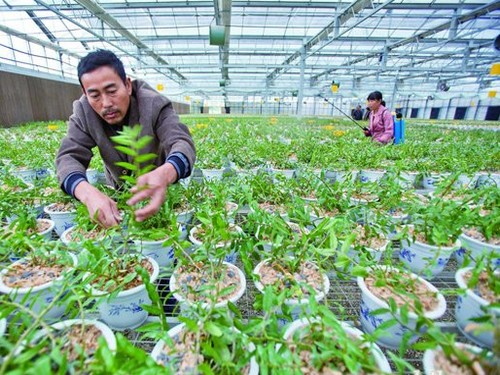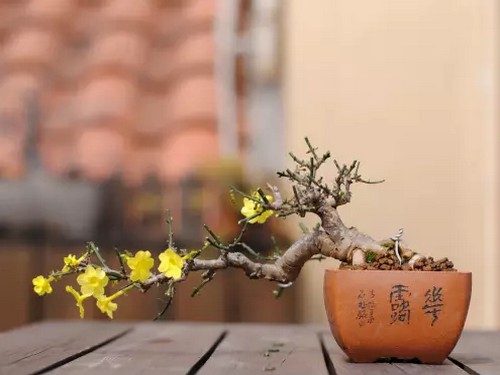Scientific fertilization method of tree stump bonsai
Stump bonsai fertilization method is very important, if too much fertilizer, branches and leaves long; if lack of fertilizer, branches thin, yellow leaves, vulnerable to pests. So, here are three scientific fertilization methods for you:
One is due to quantity. The amount of fertilizer applied to bonsai tree stumps should be controlled in small amount and many times. The amount of fertilizer applied each time should be small and thin. The bonsai trees with big stumps and flourishing branches and leaves should be properly fertilized. Otherwise, less fertilizer should be applied. Generally, during the long vigorous growth period from the beginning of spring to the beginning of autumn, thin fertilizer water should be applied once every 10 days, i.e. 7 parts of water and 3 parts of fertilizer. Liquid fertilizers such as 4-6% potassium dihydrogen phosphate, Chunquan 883, Fertility Treasure and Huimanfeng can also be used for root fertilization. After the beginning of autumn, fertilizer can be applied once every 20 days, and the amount of fertilizer should be gradually reduced. After the beginning of winter, no fertilizer should be applied.
2 because of fat. Nitrogen fertilizer can promote plant growth and prosperity, pregnant buds, commonly used nitrogen fertilizer are bean cake, ammonium sulfate, urea and human and animal feces decomposed by high temperature, etc.; phosphorus fertilizer promotes colorful, fruit hypertrophy, such as calcium phosphate, broken aggregate. Potassium dihydrogen phosphate is sprayed outside the root; potassium fertilizer promotes the development of root system, material transportation and plant firmness. Potassium sulfate, potassium chloride and plant ash are often applied, and potassium dihydrogen phosphate solution can also be sprayed outside the root; at the same time, fertilization should be applied according to the growth of plants, and flexible control should be determined according to the characteristics and growth of tree species.
3 because of time. For newly planted, newly potted or newly changed soil stump bonsai, due to damage to root system, no fertilizer can be applied temporarily, and more fertilizer can be applied when the potted tree grows vigorously in spring or early summer of the next year; less fertilizer should be applied when the potted tree grows slowly in autumn, and fertilizer should be stopped when the potted tree has entered dormant period in winter; fertilizer should not be applied around noon in rainy days or high temperatures in summer, because fertilizer is easy to lose in rainy days, and it is easy to damage root system; and at high temperature, rapid evaporation of water leads to too high concentration of fertilizer solution and causes root burning; It is best to fertilize on cloudy days or in the evening; if the pot soil is slightly dry, remove the weeds in the pot first, and loosen the soil before fertilizing; this is conducive to the infiltration of fertilizer into the soil, accelerating the decomposition of fertilizer and utilization, and avoiding phytotoxicity.
To maintain a good stump bonsai, in addition to good lighting and humidity conditions, the most important thing is how to accurately control the amount of fertilizer, that is, people often say "buckle" and "put". Due to different fertilizer requirements in different growth periods, different maintenance periods, different varieties and different appreciation purposes, fertilization must be treated differently, not only to accurately grasp the appropriate amount and concentration, but also to properly adjust the proportion of nitrogen, phosphorus and potassium, so as to grasp the initiative of maintenance. Let the new pile grow satisfactory branches meeting the modeling conditions as soon as possible, and shape them as soon as possible, so that the formed pile scenery grows small and bright leaves, thick branches, and numerous flowers and fruits. Some views on "buckle" and "release" of pile landscape fertilization are discussed.
(1)"buckle" and "release" in the green period
New piles should not only be "buttoned" but preferably not fertilized, at least until summer, before they are truly viable and grow enough robust (woody flakes) to take new roots. Because the new pile still has some nutrients stored in its body at the initial stage of growth, and the basin soil also contains a small amount of fertility, the fertilizer consumption in the early stage of growth of the new pile is not large, these nutrients are enough to maintain its growth for a period of time, and because the new root is still in the embryonic stage in a short period of time, the original old root will appear a small amount of decay and death, and there is no sufficient supply system to ensure the whole pile blank. The fertilizer and water management in this period is improper and slightly too thick. It may also lead to the newly sprouted crisp and tender new roots being burned and rotted, and the original old roots rotting more seriously, which will lead to the death of new piles without oversummer. Therefore, the new pile after autumn fertilization is good, so relatively safe.
(2)"Deduction" and "Release" in Transition Period
The transitional period refers to the period when the new pile has survived for one year, but the basin has not been molded, or only the basic skeleton branch positioning rough production is done. This period should be in the "put" efforts, in the case of not hurting its roots, or according to the growth effect after fertilization to determine the concentration and quantity, try to gradually increase the amount of fertilizer, at the same time can take the root fertilization, to some valuable branches "open small kitchen", local spraying. As long as it can bear, lose no time to increase fertilization, but must always carefully observe the growth of its branches and leaves, can not blindly apply thick fertilizer, in order to safety first.
Because this period of pile blank is still in the long "body" stage, many branches are far from reaching the standard and quantity required for modeling, so only by giving enough fertilizer water can the branches reach the required standard for production as soon as possible, so as to shorten the production time.
(3)"buckle" and "put" of forming pile scene
After the pile scene is completed and the upper basin is finalized, the traditional practice is to "buckle" fertilizer as much as possible to prevent the leaves from being too large and losing proportion, affecting the appreciation effect. But I think it is better to use appropriate "release" as the main method and appropriate "buckle" as the supplementary method. Because most of the ornamental pots on the pile blank will naturally shrink after a period of maintenance, there is no need to deliberately adopt the "button" fertilizer method to control the leaves, it is best to adopt other methods such as picking leaves to control. Because ornamental potted period is very different from field planting and green pot cultivation period, especially now people generally use shallow pots, so the soil environment for pile growth is much different than green pot cultivation, not only the soil is less, nutrients are limited, but also the roots cannot be extended, many of them are exposed on the surface of pot soil, unable to absorb enough nutrients, which also limits its growth speed and leaf expansion. Therefore, after the formation of the pile scene, or timely supplement fertilization normal care is good, in order to reduce the leaves and buckle fertilizer, can only lead to pile scene malnutrition, growth gradually weakened and listless. Even if you want to control some of the excessive growth and excessive leaves of the pile scene, but also in the early stage of spring germination, short-term buckle fertilizer, to prevent unlimited expansion of leaves and pine needles long. In other stages, it is better to manage with normal fertilizer and water, supplement nutrients needed in time, and maintain normal and healthy growth, especially for flowers and fruits. If there is no potassium and phosphorus fertilizer in its pregnancy and fruit expansion stage, it is difficult to ensure its normal flowering and fruiting.
(4)"buckle" and "release" of special pile scenery
The so-called special pile scene refers to some original piles that are not very healthy, have a large area of decay, and even have only half of the live skin of the water line. The fertilizer and water management of this kind of pile scene must be careful from the beginning to the formation. Because the root system of this kind of pile blank itself is less than that of normal pile scene, and the constitution is weak, the resistance is poor, and it is very difficult to survive. The fertilizer and water management can only be carried out step by step, neither put nor buckle, so as to ensure that it can grow normally. If it is put improperly, it will hurt the root and lead to premature death; If the fertilizer is too tight, it will prevent the remaining cortex water transmission line from further thickening and expanding, and gradually degenerate and atrophy. If there is a slight mistake in management, it will also lead to death.
In a word, the fertilizer and water management system of pile scene must adopt different countermeasures according to the different conditions of each pile scene. It must not be uniform, let alone blindly apply thick fertilizer, which is more harmful than lack of fertilizer. As long as it is once, the whole pile scene can be destroyed.
Time: 2019-06-12 Click:
- Prev

Fertilization Methods and Principles of Bonsai
There are two kinds of fertilizer applied to potted plants: organic fertilizer and inorganic fertilizer. Organic fertilizer mainly includes: human manure, manure, poultry manure, green manure, bone meal, plant ash, bean cake, sesame sauce residue, etc., as well as waste organic matter in daily life such as fishy water, rice washing water, etc. Inorganic fertilizer mainly refers to various synthetic fertilizers
- Next

Fertilization methods and matters needing attention of miniature bonsai
Bonsai due to less soil, fertilization must be timely, otherwise it is easy to cause leaves yellowing, decline, branches withered. The amount of fertilizer varies with different kinds of plants. Small bonsai mainly watching flowers should continue to apply light fertilizer after flowering in order to promote more flowering in the next year.
Related
- Fuxing push coffee new agricultural production and marketing class: lack of small-scale processing plants
- Jujube rice field leisure farm deep ploughing Yilan for five years to create a space for organic food and play
- Nongyu Farm-A trial of organic papaya for brave women with advanced technology
- Four points for attention in the prevention and control of diseases and insect pests of edible fungi
- How to add nutrient solution to Edible Fungi
- Is there any good way to control edible fungus mites?
- Open Inoculation Technology of Edible Fungi
- Is there any clever way to use fertilizer for edible fungus in winter?
- What agents are used to kill the pathogens of edible fungi in the mushroom shed?
- Rapid drying of Edible Fungi

